Black staining polypores are an underappreciated cousin to hen of the woods and chicken of the woods. They have an irresistible flavor comparable to black trumpets.
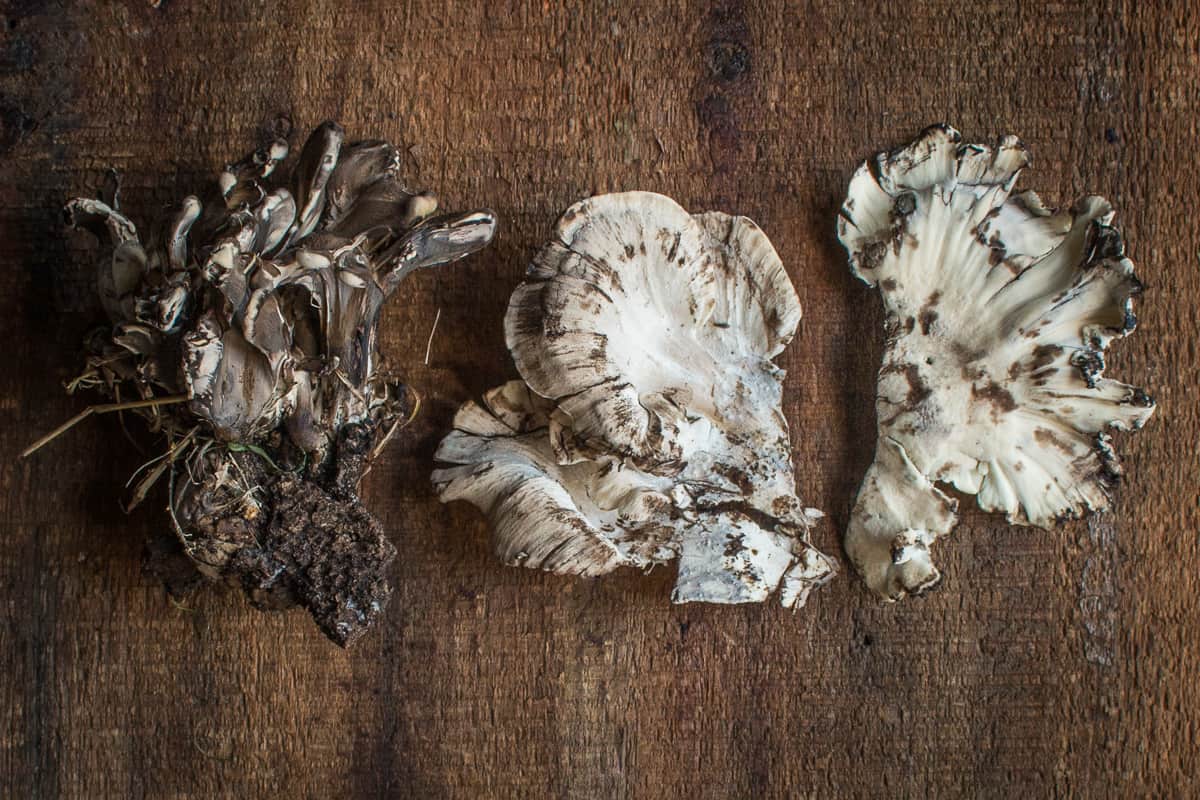
A number of years ago I got an envelope in the mail, ground dried powder of Meripilus sumstinei, the black staining polypore or rooster of the woods. it the first time someone sent me mushrooms in the mail I'd never met, which, is now a pretty regular occurrence (currently I'm waiting on honey truffles to arrive from Hungary).
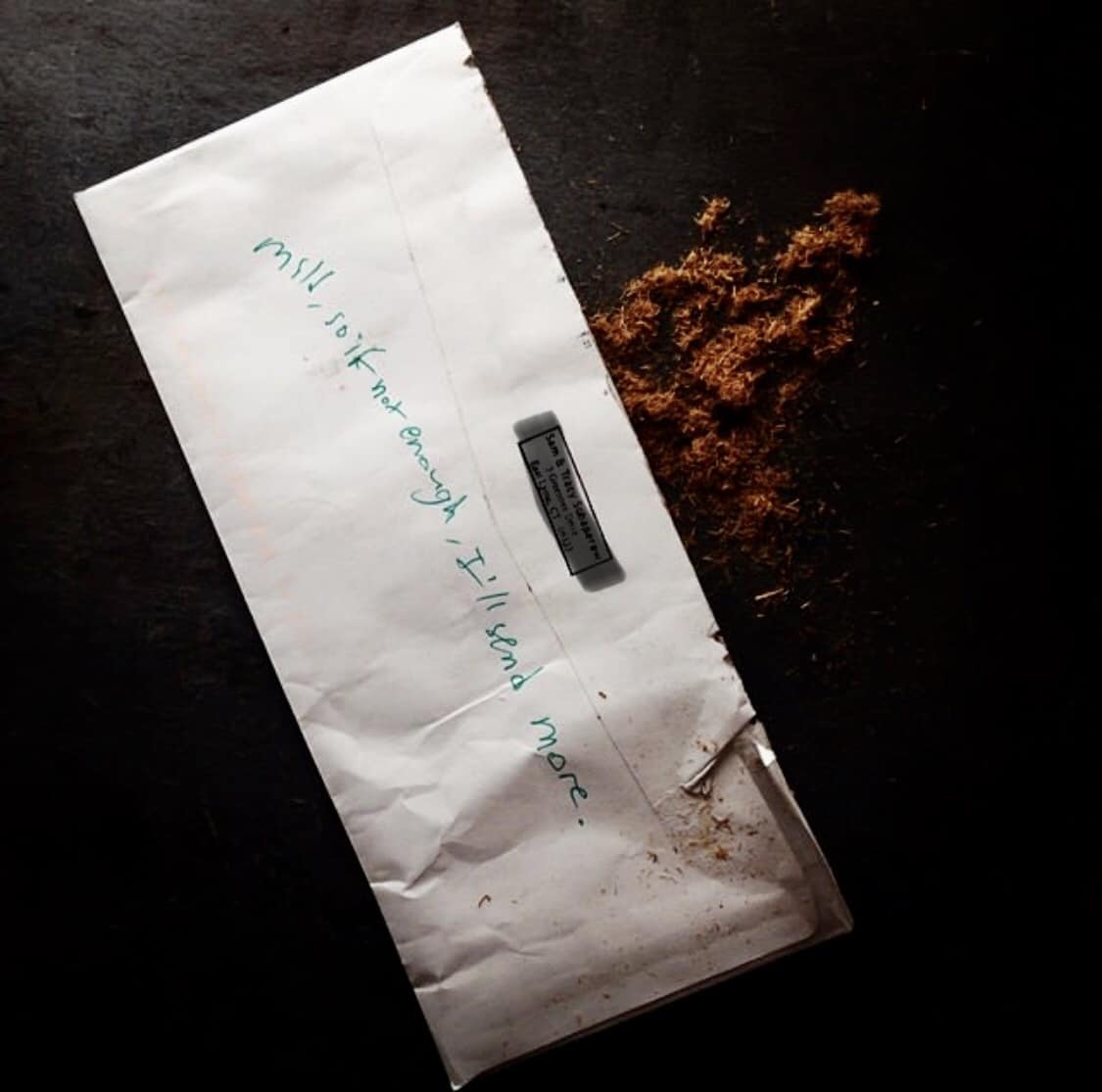
It was a small amount, not too much to play with, and I never got around to working with it. But, I remembered the name of the mushroom, and made a point of remembering the fact that someone liked them so much they felt compelled to mail them to me.
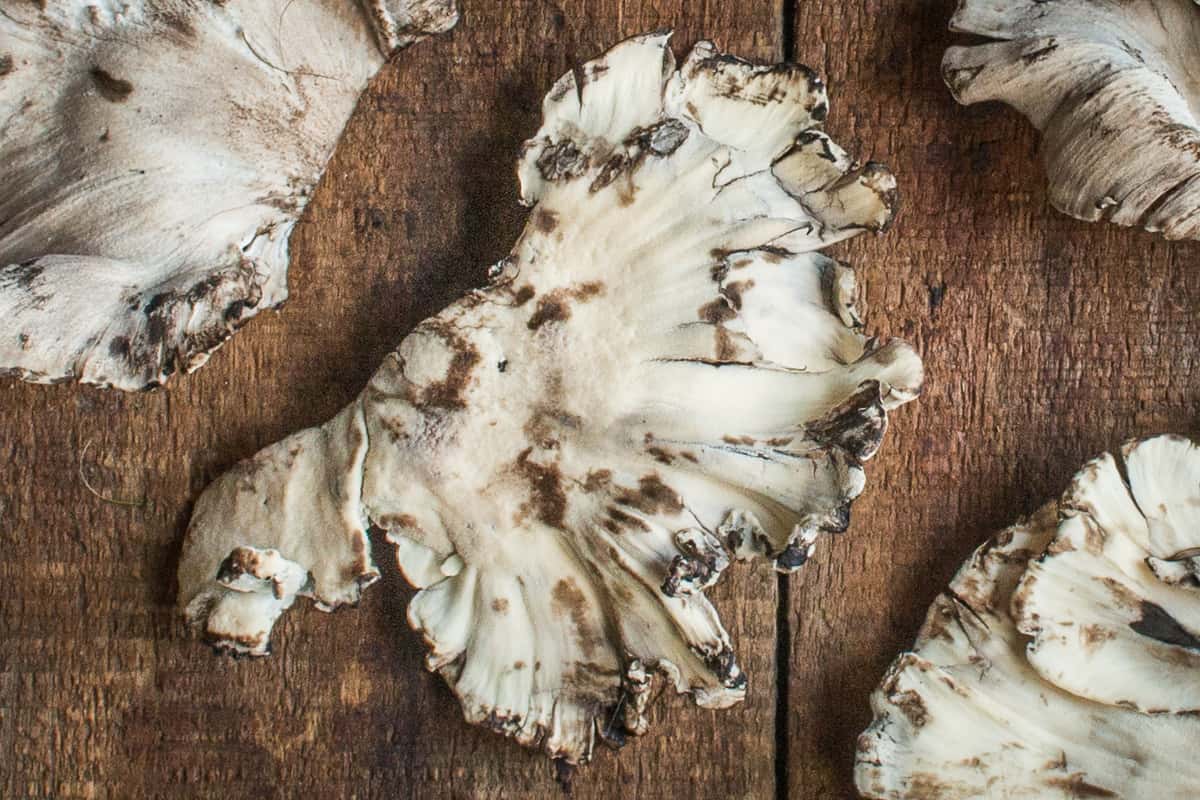
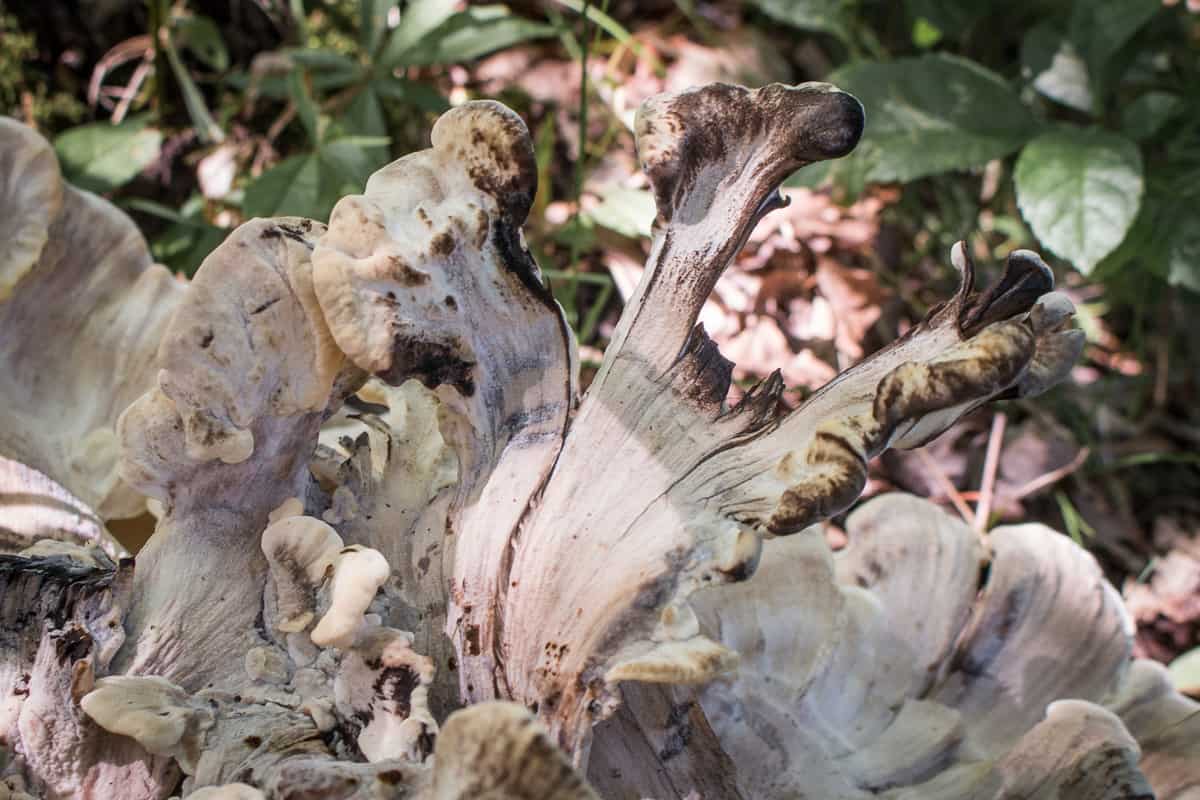
Years went by, and I forgot about them, since Meripilus is quite rare in MN and WI (I’ve never seen anyone in the area post pics of them). Not satisfied, the mushroom gods sent me another message.
Last year, my friend Jacqui mailed me a fresh specimen...from France. I walked into the communal entry at the apartment building I keep for a test kitchen and immediately smelled mushroom, a very rich mushroom. In the hallway was a little box marked with all the postal trappings of a long journey.

I grabbed the box, opened it up, and was hit with a walk of umami aroma. Unfortunately, the journey was a little too far, and temperature a little too warm, and what I could see was once a very young polypore was now a blackened lump, the paper bag it was lovingly wrapped in wet with juice. I examined it for a bit, thinking I might be able to salvage some, and, knowing how virulent mushroom poisoning can be from eating past prime things, thought better of it. The smell stayed with me though, and, even though it was past prime, it made my mouth water.
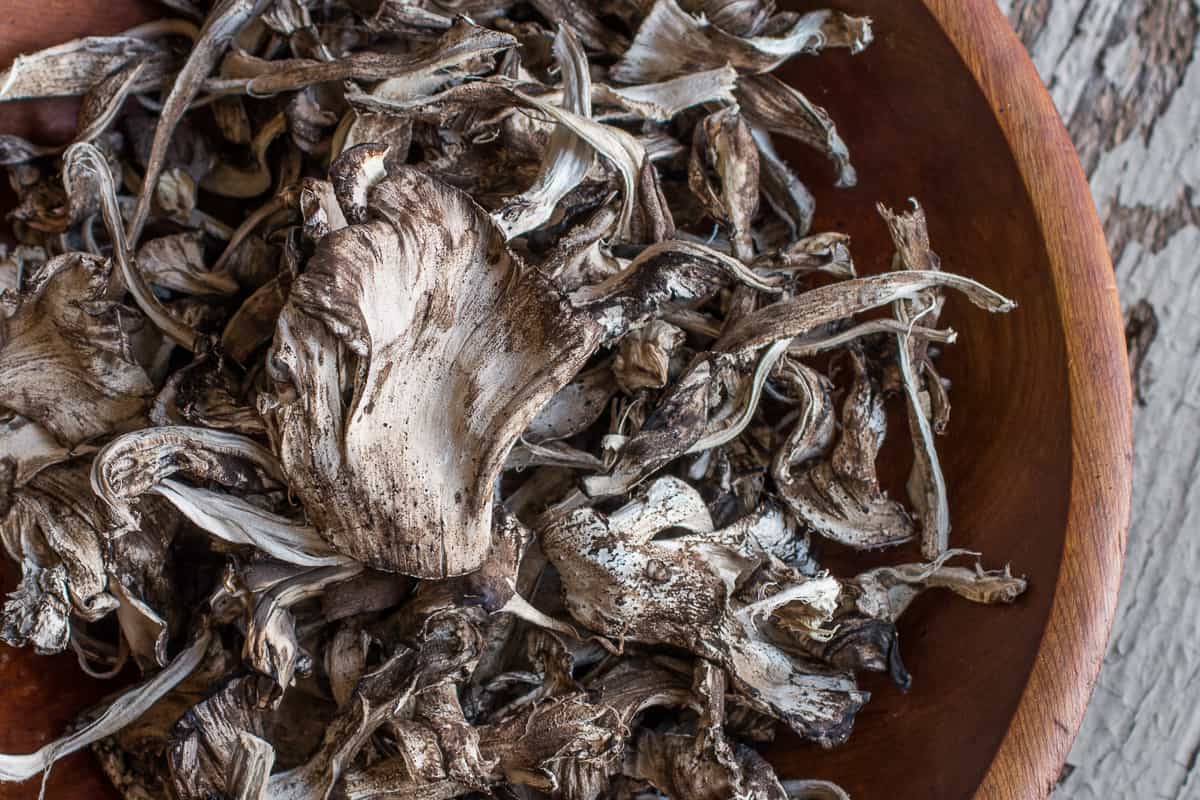
Like a lot of things in life, the third times a charm, and this year I stumbled on my own black staining polypore. It was early August, and I was checking one of my burr oak spots for porcini.
Like hens and chickens of the woods mushrooms, Meripilus sumstinei is a wood parasite, infecting trees and eating them from the inside out, appearing in a rosette shape similar to hens and others like Bonderzewia berkleyi. Mine was growing on a burr oak stump, in an area typically rife with hens, albeit at least a month early.
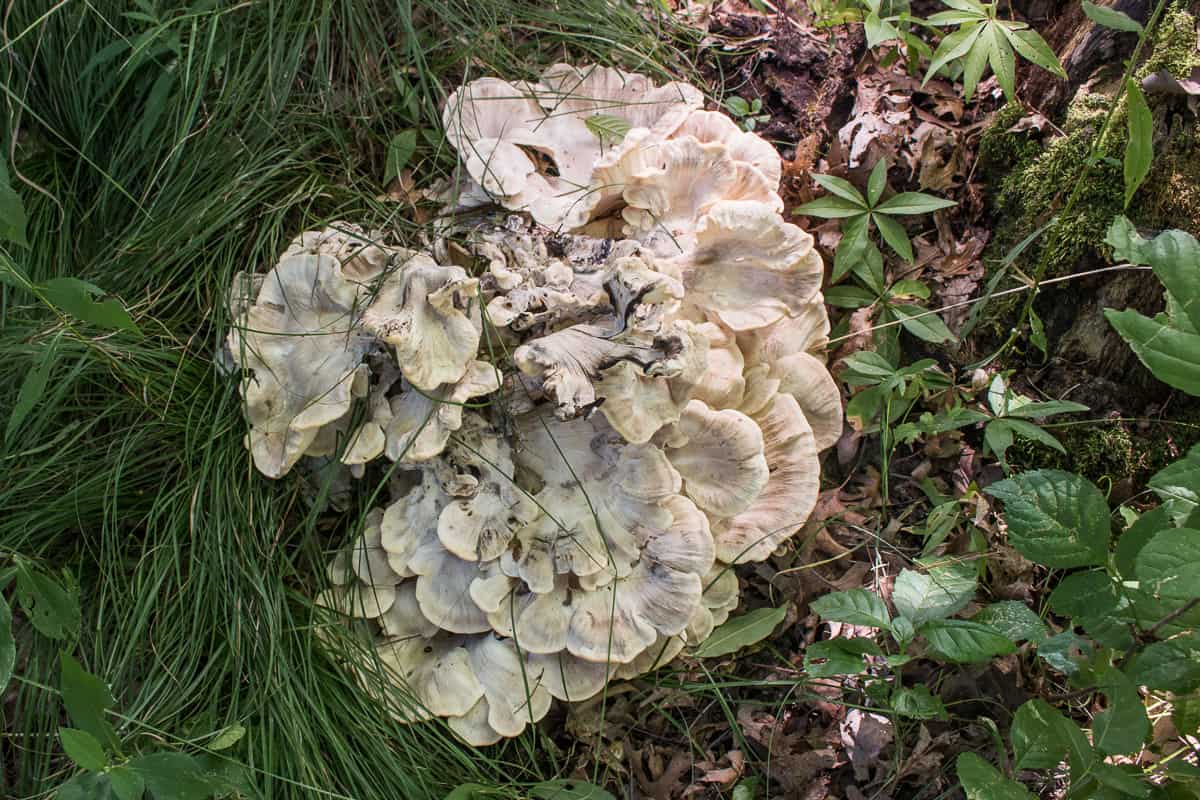
The smell, noticeable from a distance, was intense, to say the least. It's a complex aroma, that, to me evokes something like a hen of the woods crossed with a touch of black trumpet mushrooms, begging to come back to the kitchen with you.
There’s a catch though: unlike hens and chicken of the woods, black staining polypores are tough from the get-go, really tough, as in eating leather tough. The smell and flavor are so good though, that even if you brought them home and ground them up and made mushroom chew, I'd think it would be worth it, come to think of it, it's not a bad idea either.
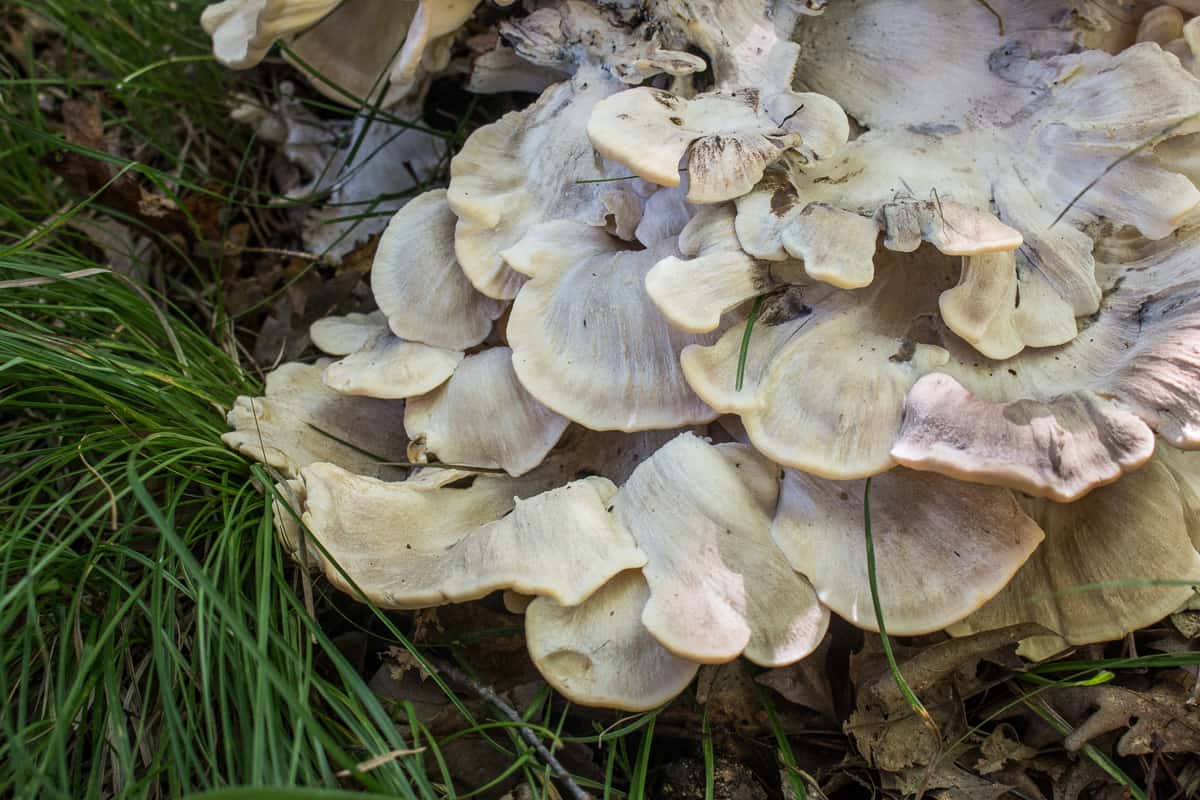
If you look online, you won’t see much other than ID blurbs though, and I was surprised to not even see a recipe online for something as obviously useful as a simple broth made from them. Furthermore, multiple others proclaim it completely inedible, and not worth your time, insinuating it should be called garbage of the woods.
After working with it intimately for the past two weeks I can tell you for certain: nothing is farther from the truth. The black staining polypore is a great mushroom for the table, with a deep, rich flavor all it's own. It’s tough, leathery texture just means you need to be creative. Claiming it's unworthy of the table is just plain laziness.

Cooking
After doing the happy dance for a while in the woods around my stump, I messaged others I know who’ve cooked Meripilus (Jacqui and @chefswild, the latter being a near bottomless resource on them).
While most of the black staining polypore will be tough as nails, the outer young margin of ½-1 Inch can be cooked fresh if sliced into a thin julienne, and it's excellent like that. It will still be slightly chewy, but it’s a good chewy, and spooned onto a steak, burger, or just straight from the pan dripping with butter, will make your toes curl from the umami.
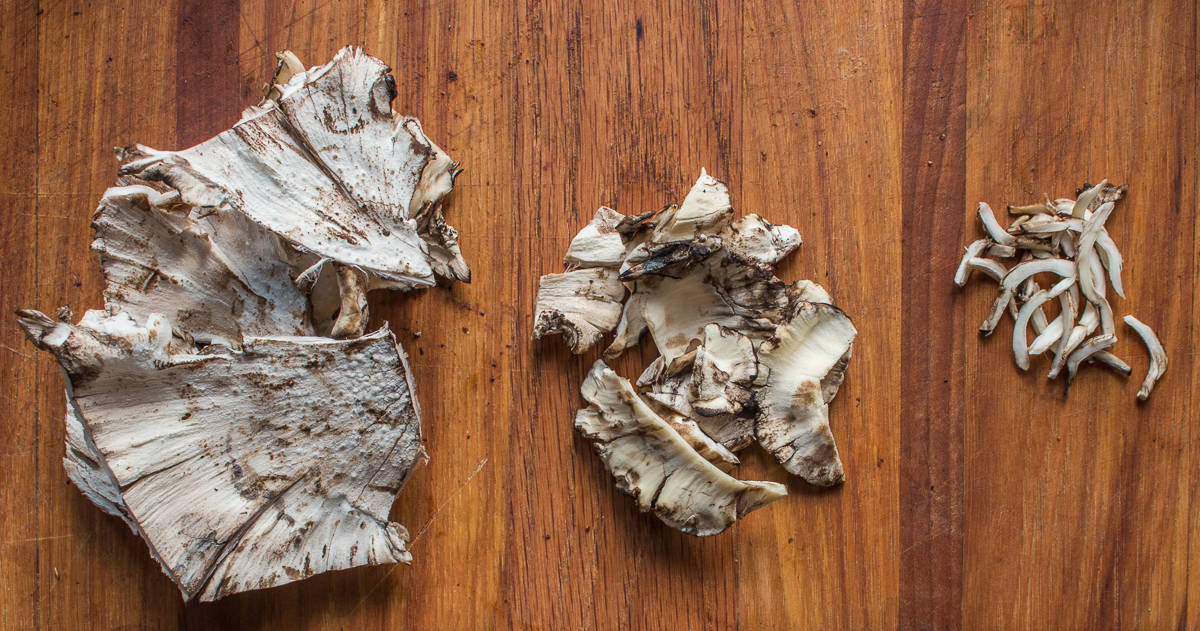
With the large mass of a polypore, harvesting say, a 5 lb mushroom and getting ¾ lb of cookable trim might seem like a poor yield, and it is, but that tender-ish trim is packed with flavor. Made into duxelles, they have near endless uses. The woody trim can be dried and used for stocks and powder.
Simmered with nothing more than a clove of garlic, a bay leaf, a few scraps of herb stems, or even all alone, with nothing more than water and some salt to finish, the final liquid is a deep tasting mushroom nectar that cries out to be the base of ramen, dashi, or a light broth, or used as the base for something like risotto, where the duxellles can be stirred back in to reinforce that special Meripilus flavor.
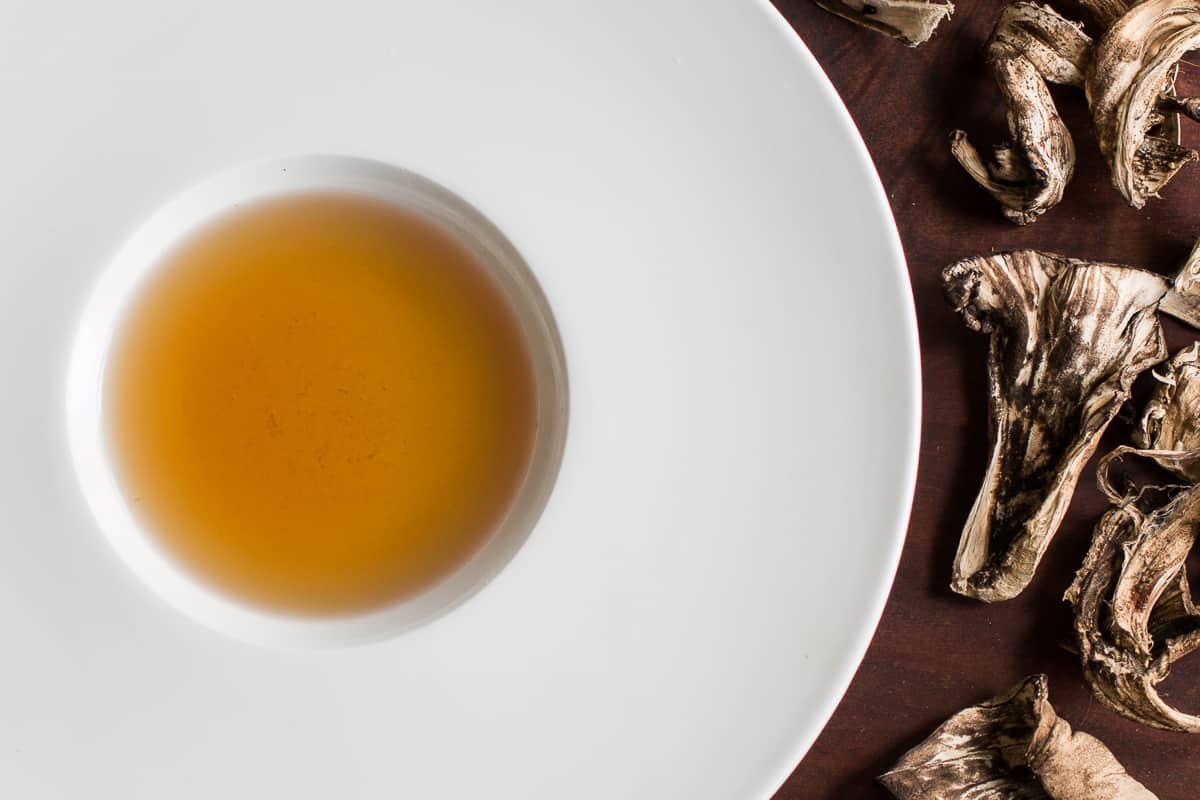
Hands down the crowd favorite I've made so far was inspired by a 100% black staining polypore burger @chefswild made. I didn’t have enough to make multiple burgers, so I channeled the James Beard blended burger project and mixed my duxelles with fresh ground beef from the farm.
They were one of the best burgers I’ve had to date, with the mushroom flavor coming through even alongside typical sharp condiments like mustard and pickles.
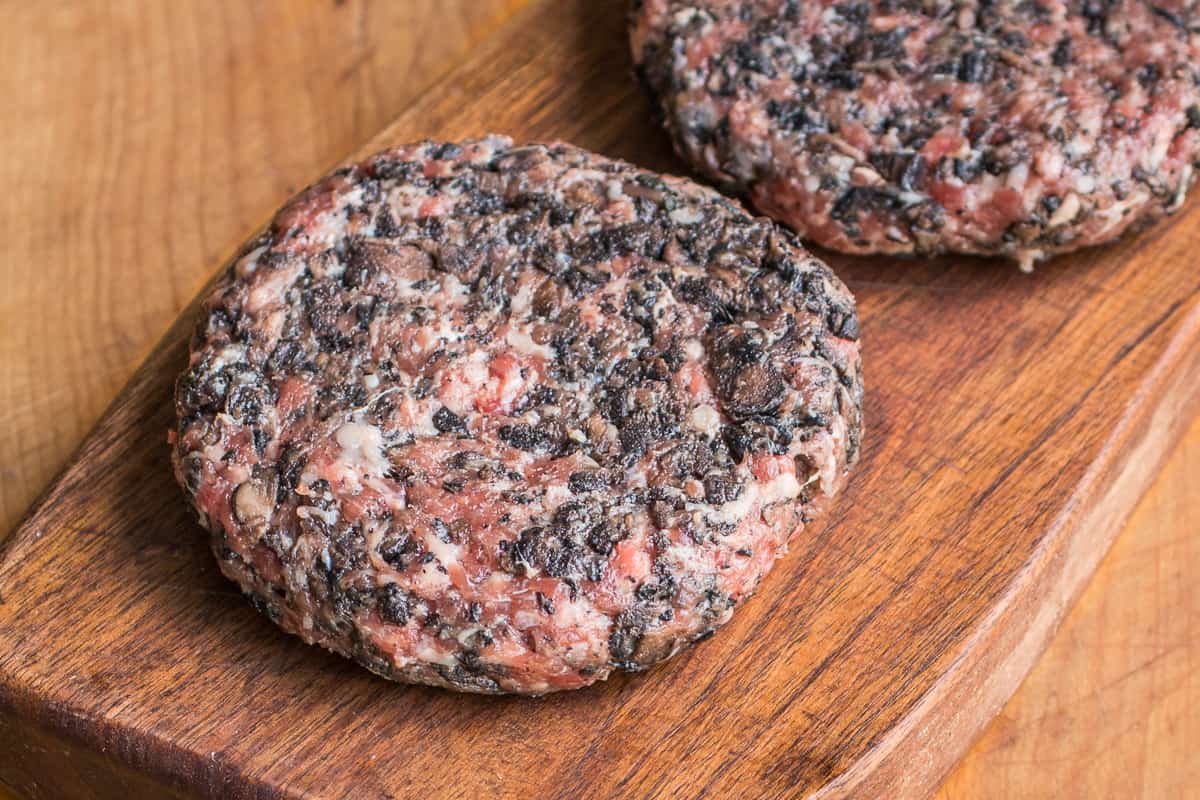
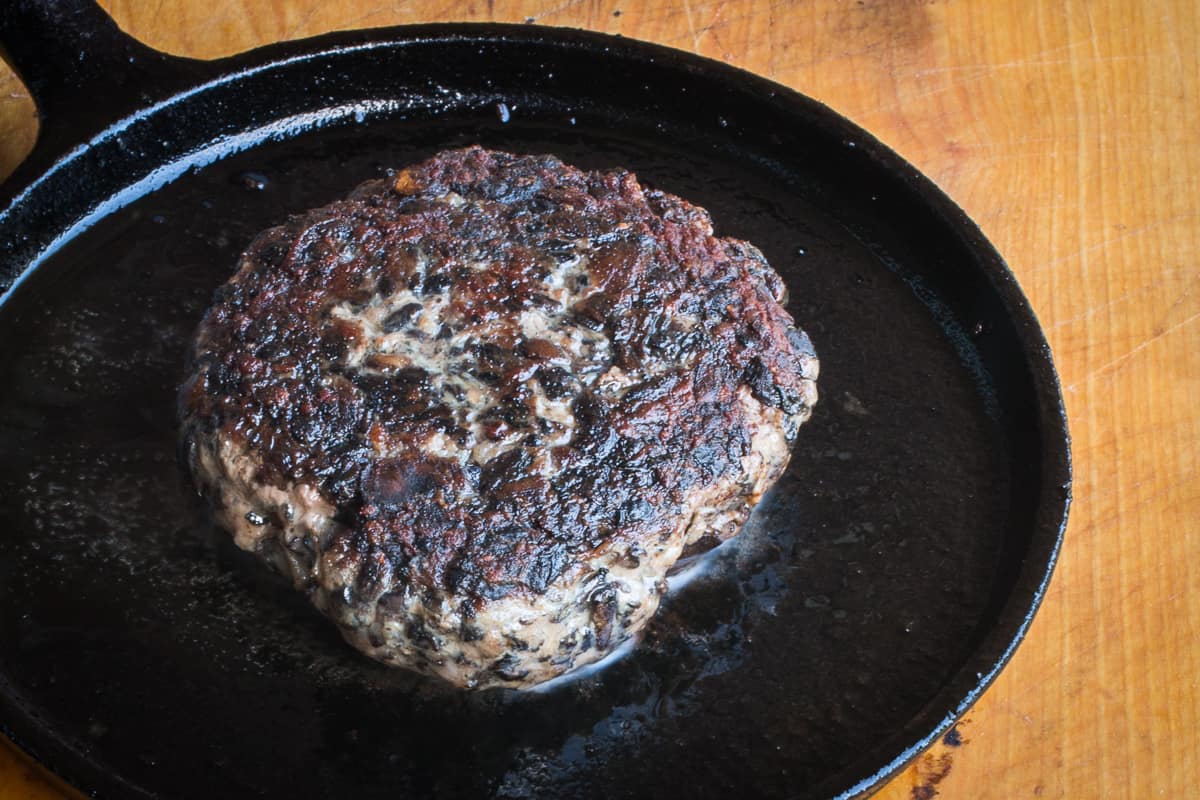
There's lots of possibilities for using these mushrooms. So, in closing, if you come across a black staining polypore, consider bringing some back with you to experiment with. And, if someone brushes them off and says they’re not worth eating, consider inviting them over to eat their words, or maybe drink them in a cup of broth. They're a mushroom definitely worth the extra work it might take to get to know them.
Black Staining Polypore Broth
Ingredients
- 4 cups chopped Black staining polypore mushrooms, roughly 1 inch or smaller pieces, or simply torn
- 1 fresh bay leaf
- a few sprigs of fresh thyme
- 1 garlic clove whole
- 5 peppercorns
- ¼ of one small onion skin on
- 8 cups filtered water
- Kosher salt to taste
Instructions
- Combine all ingredients in a pot, cover, bring to a gentle simmer, and cook for 1 hour.
- Strain the stock, then cool, transfer to a labeled, dated container and refrigerate until needed. Season it to taste lightly with salt. The stock will keep for at least a week if not longer, and can be frozen.
Black Staining Polypore Risotto
Equipment
- Wooden spoon or spatula 10 inch saucepot or similar
Ingredients
- ½ cup Black staining polypore duxelles see recipe
- Kosher salt to taste
- 4-5 cups Black staining polypore stock see recipe
- ¼ cup Shallot or yellow onion diced small
- 1.5 cups Risotto rice like carnaroli, arborio, baldo, etc
- ½ cup Dry white wine
- Splash of cooking oil
Finishing
- 5 Tablespoons unsalted butter
- ¾ cup grated parmesan plus more for serving
- Fresh chopped Italian parsley or chives to garnish, optional
Instructions
- In a wide pan, say 10-12 inches diameter, sweat shallot on medium-high heat in the oil until translucent, then add the rice, stir to coat with oil and cook a few minutes more. Don’t allow the bottom of the pan to color.
- Add the wine, duxelles and salt, and cook until the pan is nearly dry, then begin ladling in the stock gradually in ½ - ¾ cup increments, waiting until the stock is absorbed before adding the next lade. Don't add salt yet if your polypore broth is seasoned.
- When the rice is just barely cooked through, add the butter, the parmesan and parsley, stir vigorously until incorporated, taste and adjust the seasoning for salt if needed, and adjust the consistency with a little extra stock. You may have extra stock leftover--that’s ok.
- The flavor should be mushroomy, cheesy, and delicious, and the risotto itself should be thick and creamy, but also flowing and loose. Portion the risotto into soup bowls. Jiggle the sides of each bowl after plating so that each bowl of risotto is flat. Serve. Pass extra grated parmesan at the table.
Meripilus Burgers
Ingredients
- 1 lb Ground beef preferably 80/20.
- 6 oz Meripilus duxelles see recipe
- Kosher salt, to taste
- Fresh ground black pepper, to taste
Instructions
- Mix the duxelles and ground beef well, then cook a small amount to taste. Depending on how strongly you season your duxelles, you may or may not want to season the burgers. Generally I season burgers ahead of time and mix for a better texture, flavor, and shelf life raw. If you can, leave the burgers uncovered in the fridge for at least a few hours before cooking for the best crust.
- Season the burgers lightly with salt and pepper, then cook over a hot fire or in a dangerously hot cast iron skillet to your desired temperature. Medium is plenty.

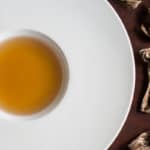


Cary
Hi Alan. I'm in the eastern NC area where this mushroom grows wildly I'm my yard. We always cut them down but they grow back quickly and bigger than the last. I am a mushroom eater and was sent this expośe to read and I am quite excited because I've also been told do not eat it, however, I'm compelled to try it. I was thinking of making it in a Jamaican style jerk marinade and pairing it with sweet fried plantains, with collard green in a spinach wrap. Would it be too tough, or do you think the marinade will possibly soften the texture. Thoughts if you can.
High Appreciate your fungal knowledge.
Cary B
Rocky Mount, NC
Alan Bergo
Hey Cary, this will be too tough. BSP needs to be finely chopped.
Wendy L
Just made an omelet of sauteed juliened black staining polypore and wood ear, both of which I found this morning in SE PA. Delicious, and just the right amount of "crunchewy" texture! A little basil pesto on top was a nice touch. Now I'm making mushroom stock with the tough ends of the Meripilus sumstinei and other mushroom bits I have collected in the freezer. Thanks for this article; I would not otherwise have known this was a tasty edible.
Alan Bergo
Thanks Wendy? Glad you liked them. And yes it’s their time right now. Friend of mine just brought me 4 lbs of tender tips.
Bennett
I love them too! Would love to see your stab at making jerky with them. I’ve tried it before with some honestly pretty solid results!
Serotonin
Hi!
I am just about to make some Meripilus Broth (and Duxelles). Was wondering if anyone prefers to use Fresh or Dried Sumstinei for the Broth.
Then I saw Mithershoe's older post, and have decided to try that.
Still interested in the potential difference between using Fresh or Dehydrated Meripilus for Broth, as tomorrow I will check on the Fungi I left behind to grow. Your thoughts?
Thanks!
Alan Bergo
Both are good but fresh if you can.
Serotonin
I can.
Thank you for the swift reply!
Love your site and all the things you do!
Edibility-wise you are my first stop for handling and processing all things Fungal.
I have learned so much.
Thank you.
Alan Bergo
You bet. Part of the gig 😄
Mark
Thank you for another master class on foraging, food prep and resourcefulness, if the latter is actually a word. As another commenter said, this is indeed a step up from chicken of the woods. I think that it is less buggy, better scent and taste. While it seems that just about all of a COTW fruit is edible, >50% of a BSP is not. I don’t care how much resolve one has, it just can’t be chewed because it is so fibrous. I tried. Maybe it would serve well as a fiber for fabric? That’s what makes the BSP broth recipe so great: nothing wasted. And the risotto was out of this world good!
Alan Bergo
Hey Mark, I’d agree there on the chickens. Unless I get a white pored one it’s so hard to get them with it bugs. Years ago when I first stumbled on my first BSP I never thought people would pick them. I’m so glad it’s been helpful.
Mark
Yes, indeed. So great that I had to write a comment. I wrote about five drafts. Writing is difficult; writing well is very difficult. Along that line of thought, we’ve enjoyed reading and using your book. Would love to read another one if you create a follow up.
Alan Bergo
Yes, the next books will come in time. Books with an independent publisher are not a source of revenue so it’s been tricky to work it into my schedule as I do this the website full time.
Bethany
I have been watching a black staining polypore like a hawk that was erupting on the side of my driveway from a tree stump we cut down five years ago. Today was the day!! It weighed almost six pounds and I had to quadruple the stock recipe. Made a double batch of the risotto for dinner tonight and it is my favorite risotto I’ve ever had. The flavor of this mushroom is absolutely incredible. Thank you for your work in demystifying mushrooms and how best to cook and enjoy them! I feel like a whole new world has been opened up to me.
Many Thanks.
Alan Bergo
Thanks Bethany. I just love these mushrooms.
Cynthia
I don't know I am making the broth now and will have risotto tomorrow from this lovely rooster of the woods. But what do I do with the muschroom after I am done with the broth, I will freeze the broth, but what about making jerkey from the cooked mushrooms?
Alan Bergo
Hi Cynthia. You can only use the mushroom for jerky if it’s very tender. I would choose another mushroom for that since making broth is typically done with the tough portion here.
Jess Roberts
Made this last night, and it was, hands down, the best risotto I’ve ever had. Thank you so much for sharing this recipe!
Alan Bergo
Hey thanks Jess!
Anna
I just want to THANK YOU for posting & researching this. I’ve moved back to family land in NC and have a huge annual flush of these. I just did a sauté with the julienned bits to try the flavor and am blown away! So good. I’m going to fold some into my gravy for thanksgiving this year. Experimenting with cuisine brings me joy and knowing i can find/eat with this just outside my door makes me so happy.
Alan Bergo
Thanks Anna
Lena D'Giulia
Anna and Alan,
Are there any poisonous look Alikes? I am in waynesville, NC and also think I have a bunch! Don’t want to eat the wrong mushroom 🙂 thanks!!
Alan Bergo
No. Check out my post on Berkeley’s I put up last week. There’s an infographic showing the most commonly confused species. This is an easy mushroom to ID: stains black, smells awesomely mushroomy.
Nurit Sonnenschein
Absolutely LOVE the smell of this black staining polypore in my kitchen!! I've been drying the main pieces for a broth which I know will be out of this world - but my attempts to use the outer edges were foiled - after sauteing for a long time, every time I tried a taste the consistency was too stringy/pulpy. I finally gave up and decided to turn it into a duxelles using my cuisinart, but even after further attempts every pinchful was just too tough. I must have gone too far into the rim and it was all mixed in together. Tasted great, but couldn't put that in kreplach or ravioli or turnovers, so I just dumped the whole thing 🙁
One important comment for anyone trying this mushroom should be to wear gloves! My nails and hands look like I just dug a grave, even after several washes and soaks in warm soapy water with a nail brush. My hands might be stained forever, LOL!
Alan Bergo
Yes you probably cut into too much of the tough part of the mushroom. Working with them is a learned skill.
Ingrid
Thank you for posting this! I found these and initially believed it was maitake. Cooking them up now!
Alan Bergo
You're welcome.
ruth dear
Haha I have been looking at my nails today wondering why they are black, now I know!!!
Alan Bergo
Yep that'll happen.
Gwen
Accidentally harvested a black staining polypore thinking it was chicken of the woods, clearly it wasn't when my hands stained black cleaning the dirt off. I am grateful I found your website. I just made broth which is amazing! (I put in one leaf of lovage.) And also made duxelles with the tips. Looking forward to using both in the risotto.
Alan Bergo
Thanks Gwen.
Woz
Blimey, I wish I’d also read your jerky recipes first! The recipes I came across used the mushrooms raw. So just to clarify for my previous post, the Blackening Polypore was RAW when I marinated it.
I’m absolutely going to order your book! Can’t believe I haven’t stumbled across your epic website before now! Thanks for sharing your In-depth knowledge and expertise. What a superb resource!
Alan Bergo
Hey thanks Woz. I'm moving right now so I've been a little slow on the draw responding. Glad you're liking the BSP, I really like those mushrooms.
Anna
I combined the advice on this blog with my Lithuanian pal's foraging advice for weird mushrooms ("Boil it!") and the result has been a resounding success - they've become a household favourite as a pulled pork substitute.
Method:
I have a nearby tree that yields 8-10 rosettes every September, so I usually grab one or two to take home. Older fruiting bodies work just fine. I pull them into palm-size fronds and parboil them in salted water for a 10 min or so. (I also then usually get lazy and leave the pot overnight to cool.) Then I fork-shred them like slow cooked pork. All but the toughest inch or so at the centre of the rosette shred wonderfully. I pack them into
tupperware and pull them out of the freezer all year for cubanos, burgers, nachos, anything you would use shredded chicken or pork for. Plus I took your suggestion on the boiling stock - it concentrates well and also lives in my freezer for all broth purposes.
Alan Bergo
The pulled BSP sounds so good! Thanks so much for sharing.
Woz
Alan, wishing I’d come across and your post sooner...I found limited information upon finding my first Blackening Polypore last week...fried a little in butter and it was delicious. Liked the taste and texture, so harvested more and decided to try making mushroom jerky for the first time...BUT MY LIMITED (after making the jerky) RESEARCH SAYS IT MUST BE COOKED!!! Do you have any insight or thoughts as to whether or not dehydrating at 60C for 8 hours would render Blackening Polypore safe to eat, or not?! I already nibbled a few pieces (delicious) before considering the cooking vs dehydrating chemistry of wild fungi. Any insight greatly appreciated.
Ashley Stanley
Thank you SO much for writing this. I have found many black staining polypores recently here in central mass.I really wasn’t sure if I wanted to put the effort in or if I even could put the effort in to bring them into the kitchen. Now I’m excited to go back and harvest them and make some fun stuff!
Alan Bergo
Thanks Ashley.
Justyn Bell
Hello!
I love to eat blackening polypore. I rate it above chicken of the woods in fact.
If you collect a very young specimen, it is only tough towards the middle. I find the outer florettes are fine to be fried while and eaten.
I think it's a banger.
Here in England it predominantly grows at the base of beech.
It is our in force ATM. I collected a kilo from a regular spot...
Two years back I got 3.5kilos from one young enough to eat!
I shall look you up on Instagram, perhaps I can post some photos.
Anyway. Lovely article. I shall read it again and put your culinary suggestions to good use!
Alan Bergo
Thanks Justyn. I haven't seen one in years. Jealous of how many you get!
Brad Ensing
I found a beautiful specimen this weekend and have trimmed up the outer edge to enjoy with some squirrel wraps today for lunch. My question is I am currently dehydrating the rest in hopes to run it thru my food processor and make a "mushroom powder" to use for BSP mushroom stock, I am wondering how many tablespoons/cups you would use of this powder for stock?
Alan Bergo
Start with 1 tablespoon per 2 cups of liquid. If you want it strong you can brew like coffee, @ 1 tbsp / cup.
Jen
I found these in southern Wisconsin last year, and this year, too. I loved the taste of them when I tried a bit, but unfortunately they made my mouth and throat swell. I didn't push it further. The taste was deep and rich.
Alan Bergo
Yeah unfortunately just like any edible polypore some people can’t tolerate them.